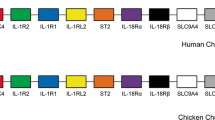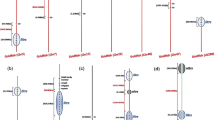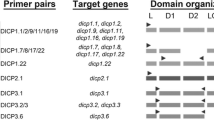Abstract
Mammalian immunoregulatory families of genes encoding activating and inhibitory Ig-like receptor pairs have been located on distinct chromosomes. In chicken, a single Ig-like receptor family with many members had been described so far. By looking at sequence similarity and synteny conservations in the chicken genome, the signal-regulatory protein (SIRP), triggering receptor expressed on myeloid cells (TREM), and CMRF35/CD300L Ig-like gene families were identified on chromosomes 20, 26, and 3, respectively. Further analysis of the three corresponding genomic regions and partial bacterial artificial chromosome sequencing were used to identify more members and to realign several contigs. All putative genomic sequences were monitored by investigating existing expressed sequence tag and cloning cDNA. This approach yielded a single pair of activating and inhibitory SIRP, two inhibitory, and one activating TREM as well as one inhibitory CMRF35/CD300L with a potentially soluble variant and an additional member lacking categorizing motifs. The CMRF35/CD300L and TREM receptors were composed of one or two V-set Ig domains, whereas in SIRP, either a single Ig V domain was present or a combination of a V and C1 domains. Like in many Ig superfamily members, separate exons encode individual Ig domains. However, in two CMRF35/CD300L genes, the signal peptide and the distal Ig domain were encoded by a single exon. In conclusion, the mammalian diversity of immunoregulatory molecules is present the chicken suggesting an important role for TREM, SIRP, and CMRF35/CD300L in a functionally conserved network.






Similar content being viewed by others
Abbreviations
- CD300L:
-
CD300 antigen like
- CHIR:
-
Chicken Ig-like receptor
- DAP:
-
DNAX activating protein
- ITIM:
-
Immunoreceptor tyrosine-based inhibitory motif
- KARAP:
-
Killer cell-activating receptor-associated protein
- KIR:
-
Killer cell Ig-like receptor
- LILR:
-
Leukocyte Ig-like receptor
- NCR2:
-
Natural cytotoxicity triggering receptor 2
- NILT:
-
Novel Ig-like transcript
- NITR:
-
Novel immune-type receptor
- PILR:
-
Paired Ig-like type 2 receptor
- SHP:
-
Src homology 2 domain containing protein tyrosine phosphatase
- SIRP:
-
Signal-regulatory protein
- TREM:
-
Triggering receptor expressed on myeloid cells
References
Allcock RJ, Barrow AD, Forbes S, Beck S, Trowsdale J (2003) The human TREM gene cluster at 6p21.1 encodes both activating and inhibitory single IgV domain receptors and includes NKp44. Eur J Immunol 33:567–577
Altschul SF, Madden TL, Schaffer AA, Zhang J, Zhang Z, Miller W, Lipman DJ (1997) Gapped BLAST and PSI-BLAST: a new generation of protein database search programs. Nucleic Acids Res 25:3389–3402
Barten R, Torkar M, Haude A, Trowsdale J, Wilson MJ (2001) Divergent and convergent evolution of NK-cell receptors. Trends Immunol 22:52–57
Beug H, von Kirchbach A, Doderlein G, Conscience JF, Graf T (1979) Chicken hematopoietic cells transformed by seven strains of defective avian leukemia viruses display three distinct phenotypes of differentiation. Cell 18:375–390
Borrego F, Kabat J, Kim DK, Lieto L, Maasho K, Pena J, Solana R, Coligan JE (2002) Structure and function of major histocompatibility complex (MHC) class I specific receptors expressed on human natural killer (NK) cells. Mol Immunol 38:637–660
Brown D, Trowsdale J, Allen R (2004) The LILR family: modulators of innate and adaptive immune pathways in health and disease. Tissue Antigens 64:215–225
Burshtyn DN, Yang W, Yi T, Long EO (1997) A novel phosphotyrosine motif with a critical amino acid at position -2 for the SH2 domain-mediated activation of the tyrosine phosphatase SHP-1. J Biol Chem 272:13066–13072
Campbell KS, Colonna M (2001) Human natural killer cell receptors and signal transduction. Int Rev Immunol 20:333–370
Cantoni C, Ponassi M, Biassoni R, Conte R, Spallarossa A, Moretta A, Moretta L, Bolognesi M, Bordo D (2003) The three-dimensional structure of the human NK cell receptor NKp44, a triggering partner in natural cytotoxicity. Structure (Camb) 11:725–734
Chenna R, Sugawara H, Koike T, Lopez R, Gibson TJ, Higgins DG, Thompson JD (2003) Multiple sequence alignment with the Clustal series of programs. Nucleic Acids Res 31:3497–3500
Chung DH, Humphrey MB, Nakamura MC, Ginzinger DG, Seaman WE, Daws MR (2003) CMRF-35-like molecule-1, a novel mouse myeloid receptor, can inhibit osteoclast formation. J Immunol 171:6541–6548
Clark GJ, Cooper B, Fitzpatrick S, Green BJ, Hart DN (2001) The gene encoding the immunoregulatory signaling molecule CMRF-35A localized to human chromosome 17 in close proximity to other members of the CMRF-35 family. Tissue Antigens 57:415–423
Clevers H, Alarcon B, Wileman T, Terhorst C (1988) The T cell receptor/CD3 complex: a dynamic protein ensemble. Annu Rev Immunol 6:629–662
Colonna M (2003) TREMs in the immune system and beyond. Nat Rev Immunol 3:445–453
Dennis G Jr, Kubagawa H, Cooper MD (2000) Paired Ig-like receptor homologs in birds and mammals share a common ancestor with mammalian Fc receptors. Proc Natl Acad Sci USA 97:13245–13250
Du Pasquier L (2000) The phylogenetic origin of antigen-specific receptors. Curr Top Microbiol Immunol 248:160–185
Göbel TWF (2000) Isolation and analysis of natural killer cells in chickens. Methods Mol Biol 121:337–345
Hillier LW, Miller W, Birney E, Warren W, Hardison RC, Ponting CP, Bork P, Burt DW, Groenen MA, Delany ME, Dodgson JB, Chinwalla AT, Cliften PF, Clifton SW, Delehaunty KD, Fronick C, Fulton RS, Graves TA, Kremitzki C, Layman D, Magrini V, McPherson JD, Miner TL, Minx P, Nash WE, Nhan MN, Nelson JO, Oddy LG, Pohl CS, Randall-Maher J, Smith SM, Wallis JW, Yang SP, Romanov MN, Rondelli CM, Paton B, Smith J, Morrice D, Daniels L, Tempest HG, Robertson L, Masabanda JS, Griffin DK, Vignal A, Fillon V, Jacobbson L, Kerje S, Andersson L, Crooijmans RP, Aerts J, van der Poel JJ, Ellegren H, Caldwell RB, Hubbard SJ, Grafham DV, Kierzek AM, McLaren SR, Overton IM, Arakawa H, Beattie KJ, Bezzubov Y, Boardman PE, Bonfield JK, Croning MD, Davies RM, Francis MD, Humphray SJ, Scott CE, Taylor RG, Tickle C, Brown WR, Rogers J, Buerstedde JM, Wilson SA, Stubbs L, Ovcharenko I, Gordon L, Lucas S, Miller MM, Inoko H, Shiina T, Kaufman J, Salomonsen J, Skjoedt K, Wong GK, Wang J, Liu B, Yu J, Yang H, Nefedov M, Koriabine M, Dejong PJ, Goodstadt L, Webber C, Dickens NJ, Letunic I, Suyama M, Torrents D, von Mering C, Zdobnov EM et al (2004) Sequence and comparative analysis of the chicken genome provide unique perspectives on vertebrate evolution. Nature 432:695–716
Kasinrerk W, Fiebiger E, Stefanova I, Baumruker T, Knapp W, Stockinger H (1992) Human leukocyte activation antigen M6, a member of the Ig superfamily, is the species homologue of rat OX-47, mouse basigin, and chicken HT7 molecule. J Immunol 149:847–854
Kaufman J, Milne S, Göbel TW, Walker BA, Jacob JP, Auffray C, Zoorob R, Beck S (1999) The chicken B locus is a minimal essential major histocompatibility complex. Nature 401:923–925
Kharitonenkov A, Chen Z, Sures I, Wang H, Schilling J, Ullrich A (1997) A family of proteins that inhibit signalling through tyrosine kinase receptors. Nature 386:181–186
Kumar S, Tamura K, Nei M (2004) MEGA3: Integrated software for molecular evolutionary genetics analysis and sequence alignment. Brief Bioinform 5:150–163
Lenschow DJ, Walunas TL, Bluestone JA (1996) CD28/B7 system of T cell costimulation. Annu Rev Immunol 14:233–258
Letunic I, Copley RR, Schmidt S, Ciccarelli FD, Doerks T, Schultz J, Ponting CP, Bork P (2004) SMART 4.0: towards genomic data integration. Nucleic Acids Res 32:D142–D144 (Database issue)
Liu Y, Buhring HJ, Zen K, Burst SL, Schnell FJ, Williams IR, Parkos CA (2002) Signal regulatory protein (SIRPalpha), a cellular ligand for CD47, regulates neutrophil transmigration. J Biol Chem 277:10028–10036
Ljunggren HG, Karre K (1990) In search of the missing self: MHC molecules and NK cell recognition. Immunol Today 11:237–244
Long EO (1999) Regulation of immune responses through inhibitory receptors. Annu Rev Immunol 17:875–904
Maglott D, Ostell J, Pruitt KD, Tatusova T (2005) Entrez gene: gene-centered information at NCBI. Nucleic Acids Res 33:D54–D58
Moretta L, Moretta A (2004) Unravelling natural killer cell function: triggering and inhibitory human NK receptors. EMBO J 23:255–259
Ogura H, Fujiwara T (1987) Establishment and characterization of a virus-free chick cell line. Acta Med Okayama 41:141–143
Peck R, Murthy KK, Vainio O (1982) Expression of B-L (Ia-like) antigens on macrophages from chicken lymphoid organs. J Immunol 129:4–5
Ravetch JV, Lanier LL (2000) Immune inhibitory receptors. Science 290:84–89
Schultz J, Milpetz F, Bork P, Ponting CP (1998) SMART, a simple modular architecture research tool: identification of signaling domains. Proc Natl Acad Sci USA 95:5857–5864
Stet RJ, Hermsen T, Westphal AH, Jukes J, Engelsma M, Lidy Verburg-van Kemenade BM, Dortmans J, Aveiro J, Savelkoul HF (2005) Novel immunoglobulin-like transcripts in teleost fish encode polymorphic receptors with cytoplasmic ITAM or ITIM and a new structural Ig domain similar to the natural cytotoxicity receptor NKp44. Immunogenetics 57:77–89
Tomasello E, Blery M, Vely E, Vivier E (2000) Signaling pathways engaged by NK cell receptors: double concerto for activating receptors, inhibitory receptors and NK cells. Semin Immunol 12:139–147
van den Berg TK, Yoder JA, Litman GW (2004) On the origins of adaptive immunity: innate immune receptors join the tale. Trends Immunol 25:11–16
Viertlboeck BC, Crooijmans RP, Groenen MA, Gobel TW (2004) Chicken Ig-like receptor B2, a member of a multigene family, is mainly expressed on B lymphocytes, recruits both Src homology 2 domain containing protein tyrosine phosphatase (SHP)-1 and SHP-2, and inhibits proliferation. J Immunol 173:7385–7393
Viertlboeck BC, Habermann FA, Schmitt R, Groenen MA, Du Pasquier L, Gobel TW (2005) The chicken leukocyte receptor complex: a highly diverse multigene family encoding at least six structurally distinct receptor types. J Immunol 175:385–393
Vivier E, Malissen B (2005) Innate and adaptive immunity: specificities and signaling hierarchies revisited. Nat Immunol 6:17–21
Williams AF, Barclay AN (1988) The immunoglobulin superfamily-domains for cell surface recognition. Annu Rev Immunol 6:381–405
Acknowledgements
We cordially thank Drs. L. du Pasquier and M. Groenen for helpful discussions. The BAC clones were provided by the BACPAC Resources of the Children’s Hospital Oakland.
Author information
Authors and Affiliations
Corresponding author
Rights and permissions
About this article
Cite this article
Viertlboeck, B.C., Schmitt, R. & Göbel, T.W. The chicken immunoregulatory receptor families SIRP, TREM, and CMRF35/CD300L. Immunogenetics 58, 180–190 (2006). https://doi.org/10.1007/s00251-006-0091-8
Received:
Accepted:
Published:
Issue Date:
DOI: https://doi.org/10.1007/s00251-006-0091-8




